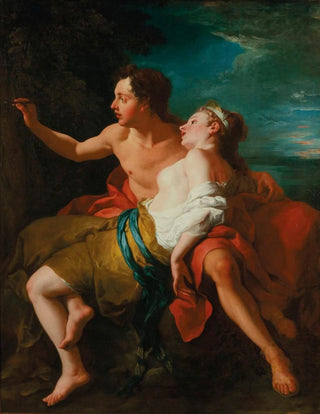Art print | Paris and Œnone - Jean-François de Troy


View from behind

Frame (optional)
Paris and Œnone - Jean-François de Troy – Captivating Introduction
In the world of art, certain works evoke mythological stories while capturing the essence of a particular era. "Paris and Œnone" by Jean-François de Troy is one of those masterful pieces that transcend the mere frame of painting. This artwork, inspired by the legend of Greek mythology, depicts Paris, the Trojan prince, and Œnone, the nymph of Mount Ida, in a poignant and tragic moment of intimacy. Immersing oneself in this composition, the viewer is transported to a universe where beauty and melancholy meet, where every detail tells a story filled with emotion. The depiction of this mythic couple evokes feelings of love, loss, and destiny, making this piece essential for art enthusiasts.
Style and uniqueness of the work
Jean-François de Troy's style is distinguished by remarkable finesse and delicacy, characteristic of the Rococo movement that emerged in the 18th century. In "Paris and Œnone," the artist employs a palette of soft, luminous colors, creating a romantic atmosphere that envelops the central figures. The drapery of the clothing, treated with an airy lightness, seems to dance under the light, while the expressions of the characters reveal psychological depth. Every element of the composition, from delicate flowers to background landscapes, contributes to a harmonious balance, inviting the viewer to explore the subtleties of the scene. This work stands out not only for its refined technique but also for its ability to evoke universal emotions, making it a piece of rare beauty.
The artist and his influence
Jean-François de Troy, a French painter of the 18th century, left his mark on his era through his talent and artistic vision. Trained in the workshop of great masters, he developed a personal style that combines classicism and Baroque influences. His works, often inspired by mythology and literature, demonstrate a particular sensitivity to themes of love and passion. De Troy also played a significant role as a teacher and mentor to many emerging artists, thus contributing to the dissemination of his aesthetic. His

Matte finish

View from behind

Frame (optional)
Paris and Œnone - Jean-François de Troy – Captivating Introduction
In the world of art, certain works evoke mythological stories while capturing the essence of a particular era. "Paris and Œnone" by Jean-François de Troy is one of those masterful pieces that transcend the mere frame of painting. This artwork, inspired by the legend of Greek mythology, depicts Paris, the Trojan prince, and Œnone, the nymph of Mount Ida, in a poignant and tragic moment of intimacy. Immersing oneself in this composition, the viewer is transported to a universe where beauty and melancholy meet, where every detail tells a story filled with emotion. The depiction of this mythic couple evokes feelings of love, loss, and destiny, making this piece essential for art enthusiasts.
Style and uniqueness of the work
Jean-François de Troy's style is distinguished by remarkable finesse and delicacy, characteristic of the Rococo movement that emerged in the 18th century. In "Paris and Œnone," the artist employs a palette of soft, luminous colors, creating a romantic atmosphere that envelops the central figures. The drapery of the clothing, treated with an airy lightness, seems to dance under the light, while the expressions of the characters reveal psychological depth. Every element of the composition, from delicate flowers to background landscapes, contributes to a harmonious balance, inviting the viewer to explore the subtleties of the scene. This work stands out not only for its refined technique but also for its ability to evoke universal emotions, making it a piece of rare beauty.
The artist and his influence
Jean-François de Troy, a French painter of the 18th century, left his mark on his era through his talent and artistic vision. Trained in the workshop of great masters, he developed a personal style that combines classicism and Baroque influences. His works, often inspired by mythology and literature, demonstrate a particular sensitivity to themes of love and passion. De Troy also played a significant role as a teacher and mentor to many emerging artists, thus contributing to the dissemination of his aesthetic. His






